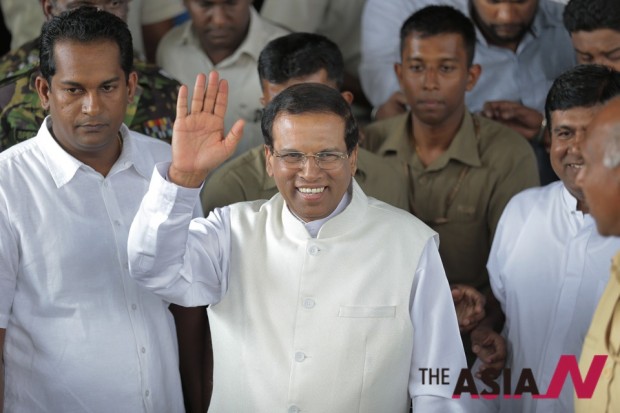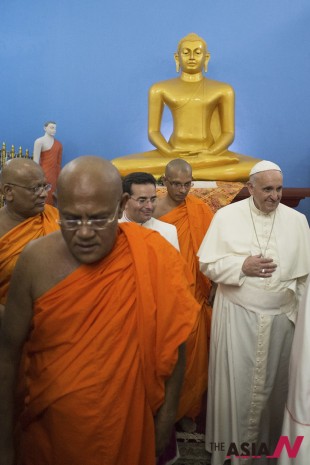
Battle continues for Sri Lanka’s “people’s power”
With the world desperately looking for a workable template to overthrow corrupt politicians and change these political structures, the latest “people’s power” demonstration in Sri Lanka may provide another opportunity, but its success like others before is still uncertain with huge challenges ahead.
Sri Lanka’s example of overthrowing the powerful long-serving President Mahinda Rajapakse through the ballot box on January 8 and his gracious exit from his official residence provides an encouraging new template for “people’s power” revolutions. Yet, people’s great expectations to stem corruption from the political system will take time to realize, if at all.
In November last year, when President Mahinda Rajapakse called a presidential election for January 8, two years before scheduled, because his trusted astrologer told him that his stars are better placed now than in two years time to win an election, no one expected him to lose. There was no credible opposition candidate who could muster enough of the Sinhala Buddhist votes to win and Maitripala Sirisena (who beat him to the presidency on January 8) was then his health minister and the ruling Sri Lanka Freedom Party’s (SLFP) general secretary.
Soon after calling the elections, President Rajapakse’s coalition ally Buddhist nationalist Jatika Hela Urumaya (JHU) defected to the opposition, and soon after Sirisena made the shocking announcement that he was standing as the opposition’s “common candidate” against the president. Even though he did not leave the SLFP, President Rajapakse, as the party president, sacked him from his position as the general secretary.
Interestingly, after his election victory, Rajapakse agreed to step down from the SLFP leadership and allowed new President Sirisena to take the position. Thus, in a stroke of irony, the general secretary who defected has now come back to lead the party, as well as the country, while Rajapakse has been elected as the party patron. In theory it will look as if nothing has changed with the same party still occupying the country’s presidency.

“Compassionate Good Governance”
Throughout the campaign the Rajapakse camp painted Sirisena and his opposition alliance called the National Democratic Front (NDF) as a Western-funded conspiracy for regime change that would result in the same chaos and anarchy like in Libya, Iraq and Syria. In turn, the Sirisena camp carried a vociferous campaign against President Rajapakse, accusing him of heading a corrupt regime packed with his relatives, drug and ethanol dealers and casino operators.
The campaign slogan of Sirisena was “Maithree Yaha Palanayak” (Compassionate Good Governance), a clever blending of Buddhist principles with the Western secular cliché. The two former Cabinet colleagues of Rajapakse, Sirisena and JHU leader Champika Ranawaka blasted the regime, particularly the Rajapakse brothers for widespread corruption, even citing Cabinet discussions and papers. The mainstream media, which had been intimidated into silence in the past for many years by the government, got a new lease of life and they reported on the election campaigning without any fear or favor, giving the opposition candidate ample space.
Rajapakse, to his credit, did not try to use intimidation to silence the media, but used the government-owned national media networks to their full potential to counter the allegations and make counter allegations of Western-funded cronies trying to provide a platform for recolonization of the country. They ignored calls by the election commissioner to stop using the government media for election propaganda.
Rajapakse started the one-month-long official election campaign in December as the front-runner, but by the New Year, the trend began to shift. The corruption allegations made by the president’s own former Cabinet colleagues were beginning to hit a nerve in the country.
There was a huge groundswell – a people’s power movement of sorts – against corruption that propelled Sirisena to presidency. Though the Western media and some of the ethnic minority politicians argue that it was the large turn out of Tamil and Muslim voters who voted for Sirisena that toppled Rajapakse, a closer scrutiny of the votes will show that Rajapakse did lose a large segment of the Sinhalese Buddhist votes, even in provinces he won.
Since Sirisena won with about a 3 percent margin of the popular vote and the minority vote was about 4.5 percent, it could be argued that the minorities helped him to tip the scales. But, taking into account that Rajapakse won with a landslide of 62 percent of votes in 2010, his vote drop constitutes about 14 percent, which means that about 10 percent of Sinhalese, mainly Buddhist voters, deserted him this time.
Many argue that the crucial factor was the defection of the close Rajapakse ally JHU, which played a leading role in bringing Rajapakse to power in 2005 and again in 2010 by helping to mobilize the Sinhala Buddhist votes. Many of the urban Buddhists have resented the rise of the Budu Bala Sena (BBS), an extremist group of Buddhist monks who were believed to be backed by Rajapakse’s brother Gotabaya, who was the defense secretary. Though JHU has not disagreed with the Buddhist grievances articulated by the BBS, they have resented its tactics of expressing it – especially monks in robes behaving like thugs.

Another reason for a significant segment of the urban Buddhists in particular deserting Rajapakse is his family’s close association with the Catholic Archbishop Cardinal Malcolm Ranjith. The invitation to Pope Francis to canonize a saint in Sri Lanka did not go down well with many Buddhists, who felt that the Catholic Church needed to first apologize for past atrocities.
It is historically documented that Portuguese Catholics have murdered Buddhist monks and virtually destroyed the Sangha (monks) order in the 17th century in Sri Lanka, and in 1752, the King of Sri Lanka sent emissaries to Ayuthaya, the then capital of Siam asking for help. The King of Siam acceded to the request and sent a team of high-ranking monks led by Phra Upali Mahathera to Sri Lanka to re-establish the Sangha order. The Thai monks spent 3 years in Sri Lanka ordaining some 600 monks and 3,000 novices.
Thus, many Buddhists believed Pope Francis should have first apologized for these atrocities before canonizing a saint on Sri Lankan soil, and President Rajapakse should have demanded it before inviting him to the island. Many Buddhists were saying privately that President Rajapakse, while claiming to represent Buddhist interests, was listening more to the cardinal than to the Mahanayakas (Buddhist prelates).
The “People’s Power” in Sri Lanka is still in its infancy and faces huge challenges. The mood of the electorate is to rid the political system of corruption and cronyism and President Sirisena has started on the correct note by even quoting from the Dhammapada on the essence of good governance in his first address to the new Cabinet. He has said that Sri Lanka does not need a king, but politicians who serve the people.
Still in infancy
“This is the first time since independence in 1948, when a new Cabinet of ministers was given such a message by a prime minister or an executive president,” noted former media advisor to President Rajapakse and veteran journalist Lucien Rajakarunanayake.
“His message was quite clear – if there is corruption, fraud and irregularities in office – there would be firm disciplinary action despite the rank or office held by a person.”
Yet, bringing the corrupt to face justice will be a huge task. There is a 100-day program that was presented to the people by the Sirisena campaign that includes independent commissions to monitor government transparency and anti-corruption bodies to bring the corrupt to justice including the Rajapakse family members and their cronies.
But, this needs a constitutional amendment that needs the votes of Rajapakse allies among the SLFP parliamentarians.
This will be a big task for President Sirisena, even though he is now the party president. Many are asking what conditions the former president will impose to deliver that vote, since Rajapakse is still popular with a large segment of the Sinhala Buddhist population for ending the 30-year-old civil war.






